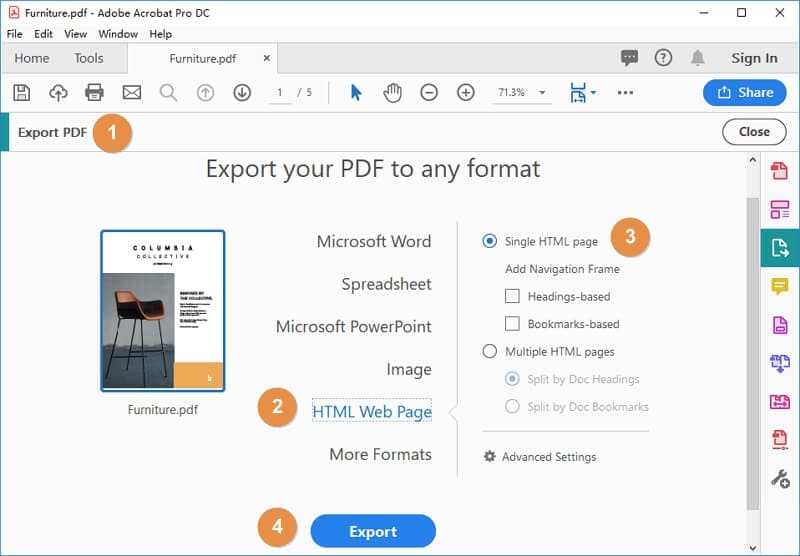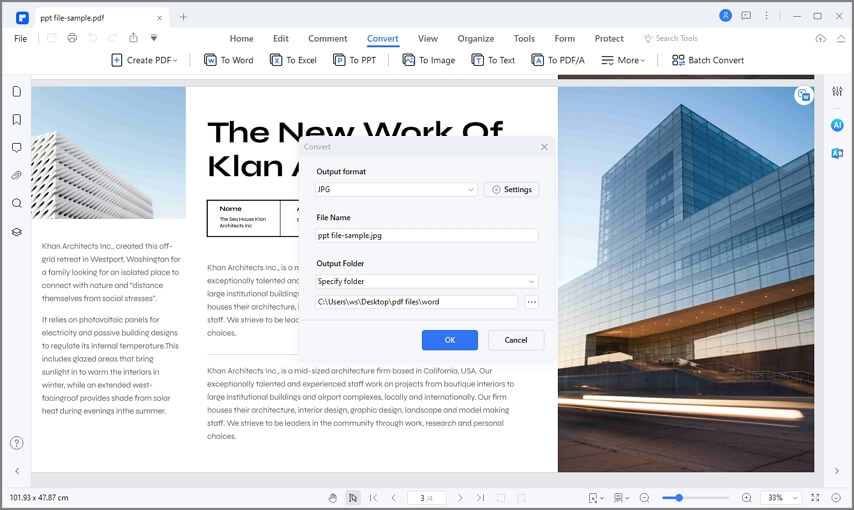 Home
>
PDF Software Comparison
> How to Convert PDF to HTML in Adobe Acrobat
Home
>
PDF Software Comparison
> How to Convert PDF to HTML in Adobe Acrobat
Before attempting to convert PDF to HTML in Adobe Acrobat DC or its Pro variant, you might want to know a little about PDF to HTML conversion and why it's needed in the first place. For starters, there are two main reasons why you would convert PDF to HTML in Adobe or any other PDF editor: distributing the document to a larger audience online and disseminating the content in a web-friendly manner. You might want to do both, but the second option requires a PDF to HTML conversion before the document can be put online for wider viewership. In this article, you'll learn the steps to convert PDF to HTML in Adobe Acrobat DC as well as a terrific and affordable Adobe Acrobat alternative called Wondershare PDFelement - PDF Editor Wondershare PDFelement Wondershare PDFelement. Let's look at the process as it is executed in these two robust PDF editors.
How to Convert PDF to HTML in Adobe Acrobat DC
In Adobe, the convert PDF to HTML option is fairly accurate as long as your PDF doesn't have too complex layout. When you launch the software, within the Create & Edit section of the Tools menu, you'll see the option to Export PDF. This is where you should navigate to after opening the document. The entire process is detailed below:

- Step 1. Launch Adobe Acrobat DC or Pro DC and use the "File" menu to open your source PDF file.
- Step 2. As outlined above, click the "Export PDF" so the pop-up window appears.
- Step 3. When you choose "HTML Web Page", Adobe will give you further options.
- Step 4. If you want a single web page to be created from the source PDF, choose that radio button; if not, choose the other option, which will render the content in several pages depending on how long your PDF is.
- Step 5. You can either click the "Export" button now or go to Advanced Settings (gear icon) to tweak other parameters like pages to be converted and so on
- Step 6. Choose the target folder for your output file and confirm the action.
In your output folder will be your HTML file. You can repeat this for multiple files. For a more intuitive experience, consider using an Adobe Acrobat DC alternative called PDFelement.
How to Convert PDF to HTML with an Adobe Acrobat Alternative
PDFelement is available in Standard and Professional variants. The conversion function essentially works the same way as in Acrobat DC and Pro DC, respectively, but the interface is a lot more user-friendly. Moreover, according to G2, "This leading alternative to Adobe® Acrobat® offers enterprise-grade PDF functionalities and perpetual licensing at a fraction of the price." So, essentially, it is an equally capable PDF editor compared to Adobe Acrobat but at a much more affordable price point. To convert PDF to an accurately rendered HTML file, follow the steps shown here:
Step 1. Open a PDF
Simply drag your PDF to the taskbar or task tray icon of the app. You can also use the "Open File" option when the software is open or the "File" → "Open" method.

Step 2. Click PDF To HTML with Adobe Alternative
When the file is open, go to the tab on top that says "Convert" and click on it. You'll see some options in the toolbar below it - click "To HTML" as your export option.

Step 3. Select Output Folder
The Save As window will now open up, where you can choose a target folder, assign a name to the output HTML file and tweak other settings. Hitting "Save" will convert the PDF to HTML and save it in the specific output folder.

You'll notice that the menu items are neatly organized and easy to find. Tooltips on all icons will show you what they're for when you mouse over them. Additional help sections are available if you get stuck at any point, and an experienced customer service team is waiting to assist you with technical difficulties.
Conclusion:
Using Adobe Acrobat DC to convert PDF to HTML can be frustrating at times. That user experience bit is where Adobe Acrobat DC fails miserably, according to many user complaints like this one:
"First timer here with Acrobat, so I'm probably doing something incorrectly. But I'm trying to convert a pdf to HTML and the results don't look good, at all. And I'm doing that with a trial version of Adobe Acrobat Pro DC running on Win 10. (Plus, I'm on Day 2 of a 7 day trial, and it isn't going well so I'm getting worried.)"
Not the best experience for a first-time user, right? To be fair, Adobe is literally the pioneer of the PDF format so, with millions of users, there are bound to be some unhappy customers. It's inevitable.
Thankfully, you can try PDFelement absolutely free. There are very few restrictions in the trial version, such as a limited number of pages during conversion and the branding watermark when you save a modified PDF file. Those can be easily removed with an affordable upgrade to PDFelement. In addition, you have apps for iOS and Android that can extend your PDF management capabilities into the realm of mobile devices with Standard or Pro features based on your license.
Let's look at just a few of the basic and advanced features you can expect:
- Create PDF documents from a wide range of source files, even merging them into one single PDF, if required.
- Annotate your PDF files with a full set of commenting and markup tools like stamps, text callouts, signature, highlighting, shapes, arrows, and other elements.
- Edit any PDF object, text, link, or image in just a few clicks. Automatic font recognition will give a sense of integration to your text modifications. You can also edit footers, watermarks and other PDF components.
- Convert a PDF file into one of many different file types for the purpose of editing them in their native applications.
- Protect your PDF workflows by setting viewing and modification passwords so only authorized users have access.
- Digitally sign PDF documents to make them legally binding.
- Conveniently fill forms even if they're not editable, with form field recognition. Simple form-filling is easy, and you can even create forms from scratch or utilize the large library of templates for this purpose.
- Perform advanced tasks like batch processing and performing OCR on scanned documents so they can be edited.
Free Download or Buy PDFelement right now!
Free Download or Buy PDFelement right now!
Try for Free right now!
Try for Free right now!
 100% Secure |
100% Secure | G2 Rating: 4.5/5 |
G2 Rating: 4.5/5 |  100% Secure
100% Secure




Shudeep C
contributor Editor